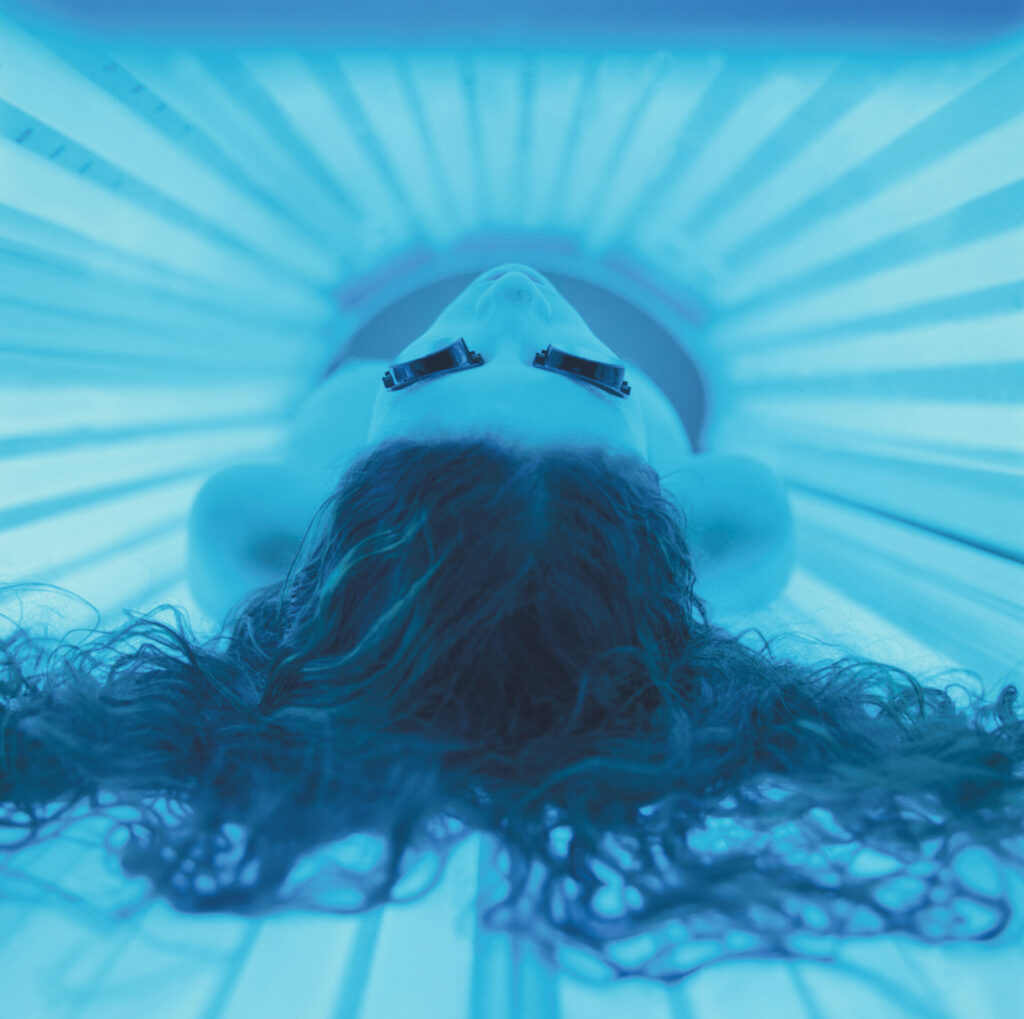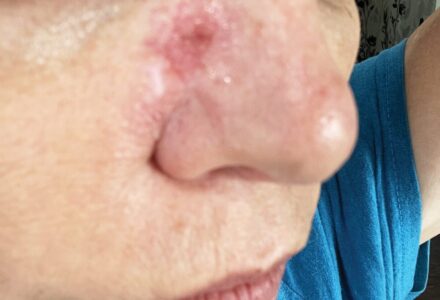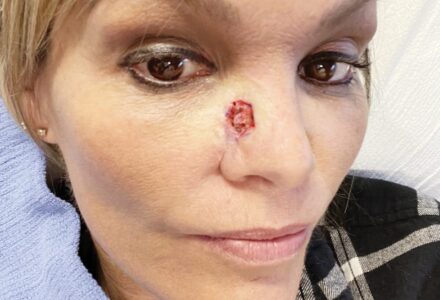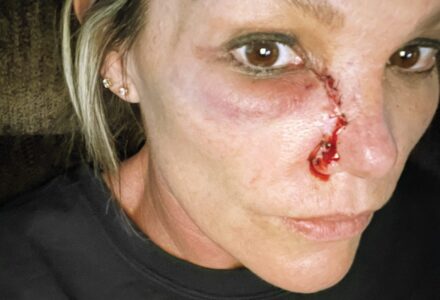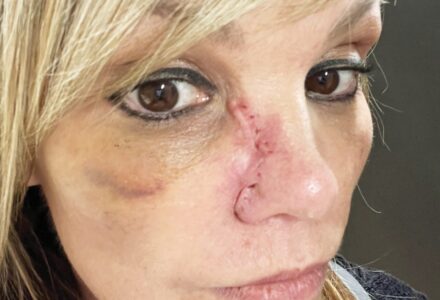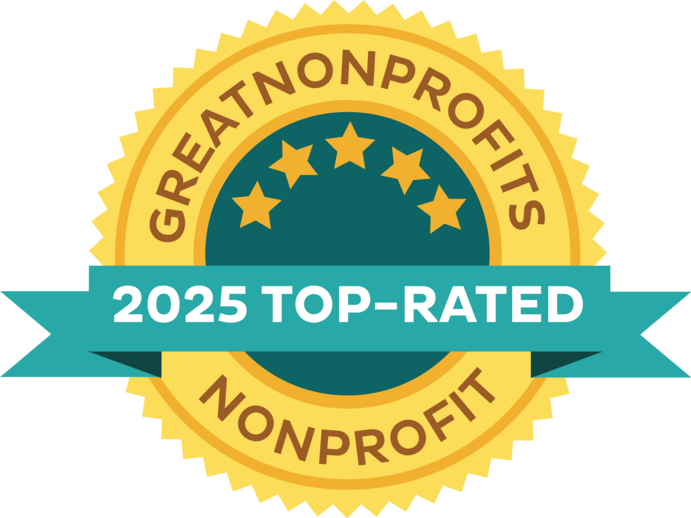Tanning beds were rising in popularity when Cassidy was in her teens. She wishes she knew then what she knows now: Indoor tanning is not safer than the sun; the devices bombard you with intense skin-damaging radiation that can lead to skin cancer.
Photo: Hans Neleman/Getty Images
As a kid, Cassidy just wanted to have fun with her friends and get tan. She never thought it would lead to 30 basal cell carcinomas. Her Mohs surgeon and his trainee want to tell her story as a cautionary tale.
By Mustufa Jafry, MD and C. William Hanke, MD
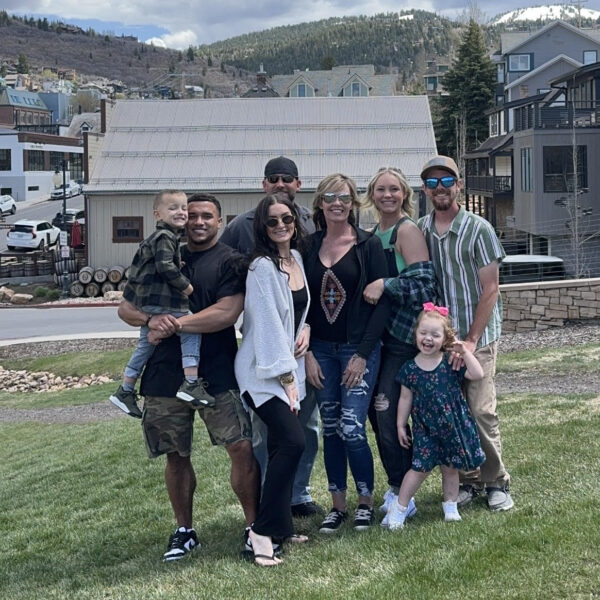
Cassidy and family in Park City, Utah
Cassidy Ward looks back on her childhood in rural Indiana with a blend of nostalgia and regret. “I spent most of the summers outside. I loved playing basketball, riding my bike and three-wheeler and helping my dad and brothers on our farm.”
The sun was a constant companion. She didn’t know it then, but so was the sun’s skin-damaging ultraviolet (UV) radiation. “Honestly, nobody really made a big deal about the sun and protecting your skin back then. My mom tried, but you know how it is when you’re a kid. You think you’re invincible!”
When Cassidy hit her teen years, cultivating a tan became part of the plan. There’s always pressure on teenage girls to look a certain way, and Cassidy had a light skin tone at a time when the cool girls had a golden tan — and the boys noticed them. “OK, I admit that I didn’t like my skin tone,” she recalls. “I thought having a tan just looked better than my pale skin, and I wanted to feel better about how I looked. Forget the sunscreen — we used baby oil!”
While Cassidy aspired to a tan, her skin didn’t like it. “It took me a while to get tan,” she explains. “I would say to my friends that I’ve got to work up to it, because I would burn. Yes, I would get red, then that would go away. I thought that was how you build a tan. I didn’t realize how much I was damaging my skin.”
Even More Dangerous Tanning
When she turned 15, Cassidy discovered the “instant gratification” of tanning beds, which were rising in popularity with teens across the U.S. “It was the mid-’90s, and while it’s easy to say we knew better then, no one talked about skin cancer.” Now we know that tanning beds expose your skin to 10 to 15 times more UV radiation than what you get from the sun. And hundreds of thousands of cases of skin cancer in the U.S. each year are linked to indoor tanning.
But in high school, Cassidy was focused more on basketball, softball and hanging out with her friends. “I tanned an average of three times a week for about five years,” she says. The tanning salon became a social hub. “All my friends tanned, too,” she says. “We would go together a lot of the time.” It was about fitting in and embracing the beauty standards of the time. “Tanning ages you and can lead to skin cancer, but you just don’t think about that when you’re young. You’re like, ‘Ah, that’s not going to happen to me.’”
The Unseen Damage
At age 35, Cassidy noticed a spot on her chest that seemed like a minor skin irritation — at first. But it didn’t go away. “It was rough and would bleed from time to time and never seemed to heal,” she says. Trusting her instincts, Cassidy decided to see dermatologist Karl W. Siebe, MD. “When I found out that the spot was a basal cell carcinoma, I remember being scared and wondering if that would lead to something worse. I never expected to hear the word ‘cancer.’ It was a life-changing moment.”
Learning that basal cell carcinoma (or BCC) is the most common form of skin cancer was little comfort. Especially since Dr. Siebe started finding more suspicious spots on her skin that needed removal and biopsy. Many more. In fact, over the next 12 years, Cassidy had more than 30 diagnosed BCCs, and many small scars.
More recently, Dr. Hanke performed three Mohs surgeries for BCCs on her face — one on her forehead and two on her face near her right eye and nose. While the procedures went well, there was a physical and emotional toll. “The ones on my face caused quite a bit of discomfort and swelling for a few days,” she explains. The aftermath of surgery included bruising, swelling and the visible reminder of scars. “After the first few days, the bruising and swelling started to go away. At my one-week appointment, I got my stitches out, and they said it looked good and was healing well.” The scars healed but serve as visible reminders of the consequences of tanning.
Changing Her Ways
Cassidy’s experiences profoundly changed how she approaches sun exposure and skin health. “I have become very aware of my skin and body, noticing any changes in a mole or a spot I didn’t have before or a spot that doesn’t heal,” she says. She does regular self-exams of her skin, and she doesn’t hesitate to consult her dermatologist if she notices anything new, changing or unusual.
While her days of tanning are long over, Cassidy sometimes still likes the idea of looking tan. “That’s when I go get a spray tan,” she says. But she knows that a faux glow does not provide sun protection. She affirms, “I never go out without my sunscreen. I wear makeup that has sunscreen in it, for extra layering of sun protection. Typically, I wear a hat and sunglasses, too. Throughout her journey, Cassidy credits her family and health-care providers for their unwavering support. “I have a wonderful family that has been there for me throughout all of this,” she says gratefully (with her husband, Travis, and grandkids, left, and with Travis, above right). And her medical team “has been so caring throughout this experience.”
Spreading the Word
Cassidy has taken proactive steps to educate herself about skin cancer and its prevention and encourages others to come here to SkinCancer.org for trusted, medically reviewed information — and not hesitate to ask questions.
Cassidy’s experiences have also fueled her desire to reach out to teenagers and young adults. “There are some risks that just aren’t worth it!” she says. She understands the mindset of youth, where immediate desires often overshadow long-term consequences. “Naively, as a teenager, I wanted to be cool and to have a tan,” she says, “which, let’s face it, was me being vain because I thought I looked better. Then years later, it caused me to start having cancer spots removed from my body.”
She hopes her story will motivate those who might be on that same path to think differently about their skin and not try to change it but protect it.
Mohs surgery, October 2024: Cassidy’s progress from before surgery to biopsy, tumor removal before closure, her nose the next morning, and one week after the stitches were removed.
Mustufa Jafry, MD, is a Mohs micrographic surgery and dermatologic oncology fellow at Ascension St. Vincent Hospital in Indianapolis.
C. William Hanke, MD, is the program director for the Micrographic Surgery and Dermatologic Oncology Fellowship Training Program at Ascension St. Vincent Hospital in Indianapolis. He also serves as a senior vice president of The Skin Cancer Foundation and is a former president of the American Academy of Dermatology.


